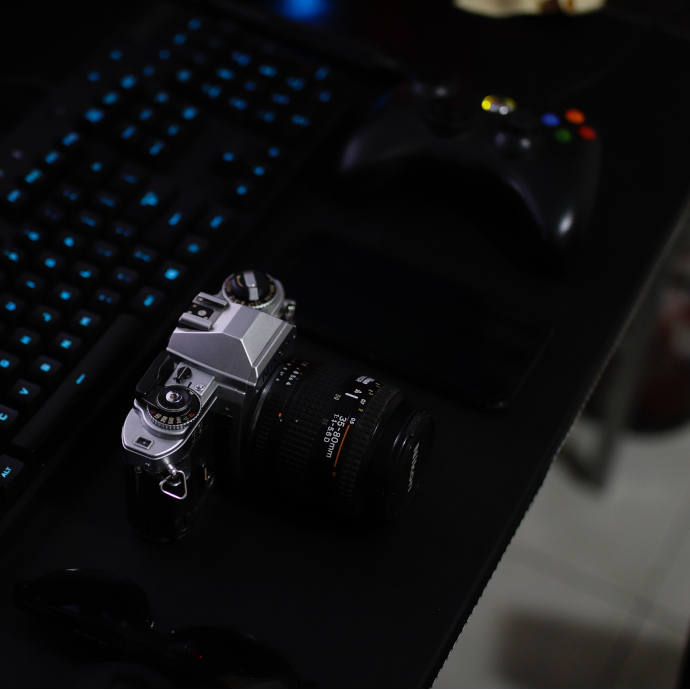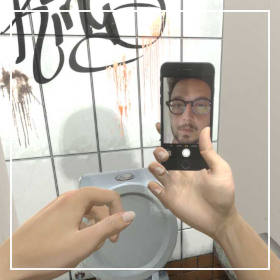I have worked as photography director for The Long Day Of Young Peng with Andrea E. Pia, with a specific focus on the role images play in the project as well as on the overall interaction design. Part of the research for the project has led me to work on the relationship between photography and computer games.
“How’s the Size? 900 pts! All right! It’s very nice!”
You have handed in your pictures for Professor Oak to review them.
“What’s the Pose? It’s rolling… 500 pts!”
You are playing Pokémon Snap (HAL Laboratory, Pax Softnica, 1999). It’s a photography game. It simulates the act of photographic capture in a safari-like ride, on an island populated by Pokémons running around in the wild.
Photography simulations are intriguing and bizarre media object: they merge representation and game rules and they short circuit image layer and algorithmic layer, surface and sub-face, semiotics and mechanics, vision and play.
Espen Aarseth: “The semiotic layer of the Game Object is the part of the game that informs the player about the game world and the game state through visual, auditory, textual and sometimes haptic feedback. The mechanical layer of the game object (its game mechanics) is the engine that drives the game action, allows the players to make their moves, and changes the game state.”(1)
These two layers inform and influence the player in different ways. The politics of representation in games are easier to single out, as photorealistic CGI graphics tend to remediate the semiotics of photography, cinema and advertisement.
Film and photography theory have long critiqued the problematic notion of objectivity of images, pointing to the embedded cultural filters within visual culture and the way representation influences and programs the viewers.
Game mechanics, on the other hand, are equally effective forces that work through an invisible layer of rules and limitations to shape players’ behavior, allowing and encouraging specific choices in order for players to win the game.
Katie Salen and Eric Zimmerman: “Game Play: the formalized, focused interaction that occurs when players follow the rules of a game in order to play it.”(2)
Game mechanics restrict the freedom of players and reduce play to a set of predefined rules and discrete choices that are made available by the game software. The tension between play’s freedom and submitting oneself to the constraint of gameplay is one of the pleasures of playing computer games.
Is it about mastering the machine or being mastered by it?
Seth Giddings and Helen Kennedy: “[…] ‘mastery’ is only one pleasure among many, […] activity and passivity are not opposites in videogame play but fluctuations in the circuit, and thus […] a new conceptual language is needed to attend to both the operations of nonhuman agency and the human pleasures of lack of agency, of being controlled, of being acted upon.” (3)
If films facilitate the viewer’s identification with key protagonists and let the spectator internalize social norms and filters through an aesthetic experience, game mechanics “program” the player through their possible scripted actions, actions that must be learnt and performed. Until a certain machinic game state is not satisfied by the player – a choice is made, a certain position is reached, a certain number of coins have been collected, an enemy is not killed – the game does not progress and the player cannot move closer to her goal.
Semiotics and game mechanics may go hand in hand, reinforcing specific narratives. Players of Grand Theft Auto V (Rockstar, 2013) move through the streets of Los Santos, the parodic version of late capitalist America that was rendered and simulated on top of “250,000 photographs and countless hours of video”(4) taken from Los Angeles.
The representational layer of GTA V reinforces problematic views of gender and race, depicting marginalized groups of people of contemporary American society in photorealistic computer graphics.
Homeless people live in tents in areas littered with garbage under flyovers, transgender individuals only exist as sex workers outside of night clubs, people of colour in Los Santos are mostly fulfilling the “gangster” stereotype.
This layer is coupled with game mechanics that reinforce the biased representations of GTA V. Homeless people have no role in gameplay, they serve no purpose in the main story line and the only interaction possible is for the player to physically attack them. The transgender sex workers can only “be heralded with disgustingly transphobic lines such as ‘Hello, sir. I mean, madam.’”(5) Black characters are more skilled at stealing cars and are more likely to take out their guns if provoked by the players.
Steffen Krüger: “ it is not advisable to bump into or provoke a member of one of the racialised minorities represented in the game that populate the poorer areas of Los Santos. The chances are, it will get the avatar killed, with armed men appearing from everywhere around, attacking without further warning. Again, the algorithmic inevitability of such a pattern results in a supposedly natural state of affairs in which racialized minorities are shown to be inevitably and naturally inclined to raw, unmitigated violence.” (6)
Alternatively, representation and algorithmic mechanics can be disjointed, indifferent from one another, with the aesthetic experience acting more like a decorative distraction from the core of gameplay and its rules.
McKenzie Wark: “In The Sims 2 you start with preset templates (Caucasian, African American, Chinese, Persian—and Elf) alterable via a lot of sub-sliders. […]but these external attributes are merely a skin. They do not really affect the game. […] The external representations are of no account; the internal variables determine potential. The “skin” is arbitrary, a difference without a distinction, mere decoration. Underneath it lies a code which is all.” (7)
Back to photography games. Back to Pokémon Snap. Back to Professor Oak’s review: “How’s the Size? 340 pts! Hmm… It’s so-so.” Photography is gamified, it must be performed by the player, it must follow the rules of the game. “How’s the Pose? 750 pts! Hmm… It’s so-so.” Professor Oak stands in his lab judging your pictures, giving points and scoring technique, size and pose. “How’s the Technique? Wait… Your Pokémon isn’t in the middle of the frame. It would have been perfect if the Pokémon were in the middle of the frame”
You are not only consuming a representation system, you are taught to perform it. “Oh, dear… your last shot was better than this.” As you master the game obtaining high scores for you images, you are trained by its narrow and strict code of what can be accepted as good photography.
Look again at Prof. Oak: he wears a lab coat and stands in his laboratory filled with machines. He is a scientist doing a portfolio review, which is somehow the perfect visualization of algorithms applied to an aesthetic analysis of photographs.

Cindy Poremba: “Photography is an inherently gamelike practice.”
Yet you cannot win in photography, or so we thought until it became quantified and ruled by algorithmic mechanics of gameplay and by a code that allows no ambiguity. Photography is reduced to only one acceptable representation system, that players have no choice but to subscribe to.
Alexandra Orlando and Betsy Brey: “The fact that Snap gamifies basic photography skills and teaches its players how to create a single kind of photographic image indicates a single acceptable or desirable kind of photography. Not only does it teach just one style, but it also discourages learning others in the game space. This can be viewed as a kind of photographic colonialism—the limitation to a single viewpoint at the expense and extinction of others by a controlling power outside of the immediate environment.” (8)
It’s all fun when confined to Huizinga’s “magic circle” of play, but gamification of photography is a phenomenon that has been spreading outside of computer games, shaping the rules of representation of social exchange on online media platforms. Within the currency of likes and followers of the so-called attention economy, the version of photography that is most effective is the one that produces what Jonathan Beller calls “fractal celebrity.”(9) This idea of computational representation flattens diversity and promotes gender inequality, racism and cultural codifications through a unique notion of successful photography:
“14 ways to make your Instagram photos stand out and get noticed”(10), “How to Take Good Instagram Photos: A Step-by-Step Guide”(11), “How to Take Better Instagram Photos: 13 Steps (with Pictures)”(12)

While the genre of photography simulation games remains a niche compared to the dominant titles of FPS and car racing games, their mechanics are directly transferable from the interface of the game camera to that of a DSLR. Because of the game-like qualities of photography itself, the relation between gamified and traditional photographic capture is arguably closer than that between shooting a gun and playing an FPS. In other words, Professor Oak remains your photography teacher even after you are done playing Pokémon Snap.
Pokémon Snap is one of many photography games, or – to be more specific – photography safari games. You are now a wildlife photographer in the fictional Manyanga Conservation Area in East Africa. The game is Afrika (Rhino Studios, 2008). You have at your disposal a number of cameras and lenses, all faithful and licensed simulations of the Sony Alpha camera series. Your clients send you tasks.
>Subject: Another photo request just came in
>From: Research Project Head Office
>The Masai Giraffe photo you sent us the other day was quite nice. You’re already creating a buzz around the office.
When we showed the photo to a bottled water manufacturer, they expressed an interest in seeing a photo of a giraffe drinking water.
Can you manage this additional request?
Manyanga Research Project
After taking and submitting your pictures, you get client evaluation reports:
>Angle: Excellent
>Target: Marvelous
>Distance: Great
>Technique: Great
Photography safaris are a special kind of photography. The photographer hunts a prey, the camera sublimates the gun. The subject of the image is unaware of the activity and possibly unwilling to be portrayed.
Susan Sontag: “One situation where people are switching from bullets to film is the photographic safari that is replacing the gun safari in East Africa. The hunters have Hasselblads instead of Winchesters; instead of looking through a telescopic sight to aim a rifle, they look through a viewfinder to frame a picture.”(13)
Pokémon Snap, Afrika, Safari Guns (New-Deal Productions SA, 1989), Wild Earth (Super X, 2006), Snapimals (BebopBee, Inc., 2015): all these games build upon a one-sided idea of photography where what is in front of the lens is mere background, with no voice in the photographic process. They reward the capture of the subjects, as if they were just another item in their inventory, an achievement trophy. It’s a unilateral relationship where the photographer dominates her prey through visual media.
Arella Azoulay: “The assumption is that the photographs show or perform something that is already over and done, foreclosing the option of seeing photography as a space of political relations.”(14)
It gets worse. In front of you now stands a female model in a swimming suit, posing next to a pool.
You are playing Paparazzi (HuneX Co. Ltd., 2004). While not technically a safari but more of a photoshoot simulation game, Paparazzi promotes an extended safari gaze. Its game mechanics are similar to those of Afrika and Snap. It simply swaps the textures and skeletons of the wild animals with that of the subservient female object of desire – including what seems to be a ridiculously exaggerated gravity force that only affects the bouncing of the breast of the model. The photographed subjects remain trapped in this violent act of dominance, the gaze of the white male (the prototypic game player of what is known in the industry as the “Hard Core”), gamified and quantified. In fact the model of Paparazzi enjoys even less freedom than the elephant in Afrika, as she is unable to leave the room, or to attack the photographer and evade the camera gaze.

Digital, networked and computational processes have reorganized sign and semiotics, quantifying forms of representation and reducing them to a binary model. Professor Oak stands as the “allegorithm” (McKenzie Wark) of the current networked image system, encouraging and rewarding a photography that offers a spectacle to be consumed, its subjects to be conveniently boxed in clear categories and with no agency.
This image system also follows a problematic tradition in photography which assumes the objectivity of reproduction and the role of the photographer as the sole agent in the scene portrayed. Scores turn into numbers and points, revealing the often tacit and hidden rules of such representation and effectively training players to conform to a view that keeps reinforcing (the creation and consumption of) images of inequality, in a society that has commodified images and has turned the photographic attention into a currency.
- Aarseth E. “Define Real, Moron! Some Remarks on Game Ontologies”, In DIGAREC Keynote-Lectures 2009/10, Potsdam University Press, Editors: Günzel, Stephan and Liebe, Michael and Mersch, Dieter, 2011. Pp..50-69.
- Salen, Katie, and Eric Zimmerman. Rules of Play: Game Design Fundamentals. The MIT Press, 2010. Chapter 22.
- Giddings, Seth, and Kennedy W. Helen. “Little Jesuses and Fuck-off Robots: On Aesthetics, Cybernetics, and Not Being Very Good at Lego Star Wars.” The Pleasures of Computer Gaming: Essays on Cultural History, Theory and Aesthetics, edited by Melanie Swalwell and Jason Wilson, McFarland & Co., 2008. pp. 13-32.
- Hoad, Phil. “From Watch Dogs to GTA V, why ‘video games are going to reshape our cities’”, The Guardian Online, 10 June 2014.
- Alexander, Mitch. “Grand Theft Auto V: Misogyny & Transphobia”. GayGamer.Net, 2013
- Krüger, Steffen. “Facing Fanon: Examining Neocolonial Aspects in Grand Theft Auto V through the Prism of the Machinima Film Finding Fanon II”, Open Library of Humanities, 4(1), 2018.
- Wark, McKenzie. Gamer Theory. Harvard Univ. Press, 2007. P.28.
- Orlando, A. and Betsey Brey. “Press A to Shoot: Pokémon Snap-shots and Gameship Ownership”, First Person Scholar, 2015. http://www.firstpersonscholar.com/press-a-to-shoot/
- Beller, Jonathan. “Informatic Labor in the Age of Computational Capital,” Lateral 5.1. 2016.
- “14 tips for amazing Instagram photographs”. BT. 15 September 2018.
- Cyca, Michelle. “How to Take Good Instagram Photos on Your Phone: A Step-by-Step Guide”. Hootsuite. 12 September 2018.
- wikiHow Staff. “How to Take Better Instagram Photos”. wikiHow. 2018.
- Susan Sontag. On Photography. RosettaBooks. 1977. P.11.
- Azoulay, Ariella. The Civil Contract of Photography, Zone Books, 2008. P.19.





